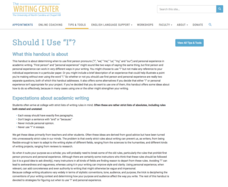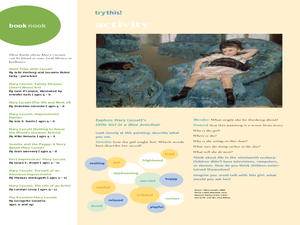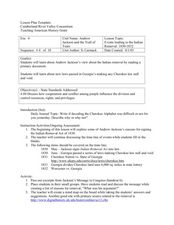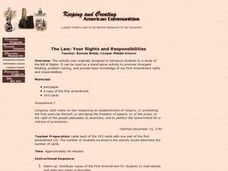Curated OER
Pause for Thought
Students discover the customs of Ramadan. In this Muslim beliefs lesson, students research the listed Web sites about the history of Ramadan, the evolution of calendars, and the separation of church and state.
Curated OER
What the Empire Lost: The Ottoman Empire
In this Ottoman Empire worksheet, students read a 1-page selection about the decline of the empire, examine the provided map on the topic, and then respond to 5 short answer questions about the information presented.
Curated OER
Metaphors
In this metaphor worksheet, students read statements that contain metaphors, then choose the statement that explains the meaning of each. A reference website if given for additional resources.
University of North Carolina
Should I Use “I”?
Despite the formal nature of academic writing, personal pronouns frequently appear in high school and college papers. While your first instinct may be to cross them out, sometimes it's okay to use them, an idea covered in a handout that...
Hump Software
The Writing Machine
Introduce your learners to the letters of the alphabet. They will tap to hear the name of each letter and see a word beginning with that letter appear on the screen. The highly repetitive nature of this app could be a good way to...
Curated OER
Every Day Is Presidents' Day at the White House
Students explore the history of the White House and the role of the president. They explore the White House Historical Association website, answer questions, create a drawing of the Oval Office, and take an online quiz.
Curated OER
Civil War and Beyond
Sixth graders play a game. In this Civil War lesson plan, 6th graders discuss the beginnings of the Civil War and define vocabulary words associated with the war such as abolitionist and Emancipation Proclamation. Students...
Curated OER
Life During the Civil War for Women and Civilians
Students follow an overview of the American Civil War from a film, the text and/or teacher direct instruction. They create a timeline with a large map of the U.S. in the 1860's available for student reference as they do the spider activity.
Curated OER
Prairie Activity: Imagist Prairie Poems
Learners write an imagist prairie poem. They explore various websites, view images of prairies, read examples of poems, and write an original poem that creates a mental image in the mind of the listener through the use of descriptive...
Curated OER
Quoting the Dalai Lama
Students read and reflect on statements made by the Dalai Lama and
discuss with cooperative group members what they believe is
meant by the statement and how to report this information the
rest of the class. They take turns presenting...
Curated OER
Proofreading: Lesson 8
Teacher reads the material that is printed in boldface type inside the boxes aloud to the students. Information in regular type inside the boxes and all information outside the boxes should not be read to the students. Possible student...
Curated OER
Mary Cassatt: Impressionist Connection
Learners read information about Mary Cassatt and study examples of her Impressionist art. In this art history lesson, students read about the life and art of Mary Cassatt. Learners then study her art 'Little Girl in a Blue Armchair.'...
Curated OER
Time-Out
Students watch the Time-Out Shrot, "Martin's Dad's Story" They work in groups to plan a Jerry Springer type of talk show. Students prepare a summary that can be read at the end of their "show" including a summary of what ha happened, the...
Curated OER
Honey Bees and Communication
Did you know that honey bees dance to communicate information? Do you know why bees use hexagons to build their hives? The Honeybee Man, Brilliant Bees, and Show me the Honey provide background information on how honey bees communicate....
Curated OER
U.S. Expansion and the Age of Empire
In this American foreign policy worksheet, learners respond to 20 essay questions about expansionism in the country during the 20th century.
Curated OER
Events Leading to the Indian Removal 1830-1832
Learners consider the effects of Indian Removal on the Cherokee Nation. In this American history lesson, students research Internet and print sources regarding the Indian Removal Act of 1830. Learners write short stories that detail the...
Curated OER
The Law: Your Rights and Responsibilities
Students explore First Amendment rights and responsibilities.
Curated OER
Weapons Of War: The Monitor
Students investigate the building of the first warships of the Civil War. They conduct research using a variety of resources. Students compare and contrast two battleships of the era using a graphic organizer. They also compose a journal...
Curated OER
Constitutional Resources
Young scholars explore the REpublican Era and the writing of the constitution and Billof Rights through various links and activities included in this collection.
Curated OER
Folklore Festivities: Exploring Short Stories
Students explore the stories of "William Tell, The Husband Who Was to Mind the House, The Little Match Girl, and Three Words of Wisdomare" in the five lessons of this unit. The understanding of folktales is highlighted in this unit.
Curated OER
Studying Locally, Teaching Globally
Students work in small groups to create outlines and mind-maps that demonstrate their understanding of the effects of outsourcing on economic relationships and the U.S. economy.
Curated OER
California's First Constitution
Students read excerpts from speeches made at the California Constitutional Convention. They predict what the state constitution say about slavery and other issues concerning race.
Curated OER
Geography Overview
Second graders look at the United States often over the next few months. Help them to see how the United States has changed as territories have become states. They may be surprised to know the areas of our country that were territories...
Curated OER
Wet Dry Ice Lab
In this wet dry ice worksheet, learners read the information about dry ice and phase change. Students perform an experiment in which they observe phase changes of ice. Learners answer analysis questions as it relates to the phase change...

























